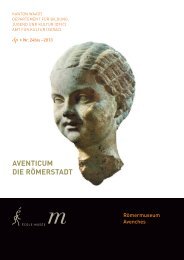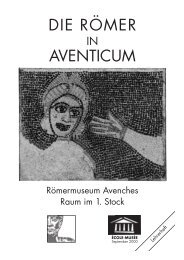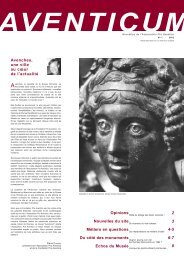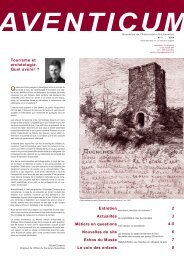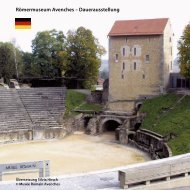Avenches – Roman Museum – Permanent Exhibition
Avenches – Roman Museum – Permanent Exhibition
Avenches – Roman Museum – Permanent Exhibition
You also want an ePaper? Increase the reach of your titles
YUMPU automatically turns print PDFs into web optimized ePapers that Google loves.
Second Floor Food<br />
Eating Habits<br />
The consumption of cheese was widespread if one chooses to believe the<br />
ancient texts, which particularly praise alpine cheese. Earthenware cheese moulds<br />
found during excavations provide evidence of cheese production.<br />
Meat such as pork, mutton, goat and less frequently poultry and fish were added<br />
to the menu as a treat on festive days.<br />
The Table of the Wealthy<br />
The best pieces of meat were reserved for the richest, who liked to eat lamb, poultry<br />
and venison. They also appreciated luxury food such as oysters and mackerel from<br />
the Mediterranean as well as “exotic” products such as pepper, melons, dates,<br />
almonds, pine kernels, garlic, bottle gourds and olives. It is certain that peaches,<br />
grapes and figs were also on the menu of the middle classes. In this region there is<br />
evidence of fishing from the 1 st century AD onwards.<br />
The Kitchen<br />
The kitchens discovered in the area were very simple. In most cases they were<br />
situated in a room at ground level with a hearth in the centre. Food was cooked in<br />
different types of vessels, which were either placed directly on the embers or on a<br />
tripod. Food was sometimes also prepared in a cauldron suspended above the fire<br />
on a hook attached to a wooden stand that could be rotated.<br />
Small supplies of honey, fruit, vegetables or dried herbs as well as certain spices<br />
and condiments were kept in storage vessels in the kitchen. More substantial<br />
supplies for the winter months were stored in amphorae or dolia (large earthenware<br />
jars) in appropriate storage rooms.<br />
Eating Habits<br />
The living quarters of poorer families were usually so cramped that the meals could<br />
not be eaten lying down; as a rule, there was no separation between the kitchen<br />
and the room where the meals were eaten.<br />
On the other hand, the villae and town houses of the rich had separate dining<br />
rooms (triclinium), which usually contained three couches arranged in a U shape<br />
(lectus triclinaris). Each couch provided room for three people.<br />
The dining room floors were often covered with mosaics and the walls were<br />
decorated with different types of murals.<br />
Women generally sat on a chair next to the couches while children and servants<br />
ate elsewhere.<br />
The different dishes were put on a small table in the middle. People usually ate<br />
with their fingers. They did not use forks or knives, but some used small spoons with<br />
pointed handles.<br />
1<br />
59<br />
Second Floor



